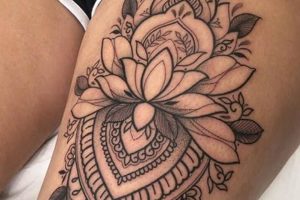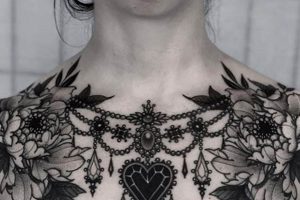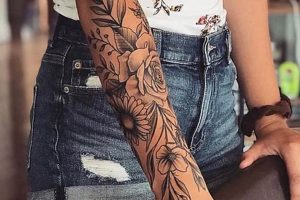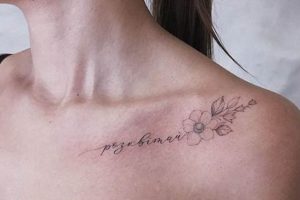Floral tattoo designs, particularly those featuring roses, remain a popular choice for women seeking expressive body art. These designs offer a wide range of stylistic interpretations, from classic to modern, minimalist to intricate, and can incorporate various colors and accompanying elements to create unique and personalized artwork. Examples include single stem roses, bouquets, rose and skull combinations, or roses intertwined with other floral motifs.
The enduring appeal of rose imagery stems from its rich symbolism. Across cultures, roses represent love, beauty, passion, and even resilience, allowing individuals to express personal narratives through their chosen design. Historically, roses have featured in art and literature, solidifying their position as powerful symbols imbued with meaning. This historical context adds further depth and significance to a rose tattoo.
The following sections will explore various design considerations, including placement on the body, color choices, and stylistic options, empowering readers to make informed decisions when selecting a rose-themed tattoo.
Tips for Choosing a Rose Tattoo
Careful consideration of several factors contributes to a successful and personally meaningful rose tattoo design. These tips offer guidance for navigating the decision-making process.
Tip 1: Research Artists: Thoroughly investigate the portfolios of several tattoo artists specializing in the desired style. Different artists possess unique strengths and artistic approaches.
Tip 2: Consider Placement: Tattoo placement impacts both visibility and how the design conforms to body contours. Smaller, delicate designs might suit the wrist or ankle, while larger, more elaborate pieces might be better suited for the back or thigh.
Tip 3: Explore Color Palettes: Color significantly influences the overall aesthetic and symbolic meaning. Classic red signifies passion, while black can represent loss or mourning. Explore various color options and their associated interpretations.
Tip 4: Reflect on Symbolism: Consider the personal meaning to be conveyed. Thorns can symbolize protection or resilience, while a blooming rose can represent new beginnings or growth.
Tip 5: Plan for Size and Detail: Intricate details require larger canvases. Discuss size limitations with the chosen artist based on the desired level of detail and preferred placement.
Tip 6: Think Long-Term: Tattoos are permanent. Reflect on the chosen designs long-term suitability and personal relevance.
Tip 7: Prioritize Aftercare: Proper aftercare is crucial for healing and preserving the vibrancy of the tattoo. Follow the artist’s instructions diligently.
By carefully considering these tips, individuals can select a rose tattoo design that reflects their personal style and desired symbolism while ensuring a positive tattooing experience.
With these essential considerations addressed, one can confidently move forward in the process of acquiring a meaningful and aesthetically pleasing rose tattoo.
1. Placement
Placement is a crucial factor in rose tattoo design, significantly influencing the overall aesthetic and how the design interacts with the body’s natural contours. Careful consideration of placement ensures the tattoo complements individual anatomy and aligns with personal preferences regarding visibility and discretion.
- Wrist and Ankle:
These locations are ideal for smaller, more delicate rose designs. The curvature of the wrist or ankle can be subtly accentuated by a strategically placed stem or vine. These placements offer a balance between visibility and the option for concealment.
- Back and Shoulder:
Larger, more intricate rose designs often find a suitable canvas on the back or shoulder. These areas provide ample space for detailed artwork, allowing for greater complexity in composition and color palettes. Shoulder placement can create a visually striking piece, especially with designs that flow along the shoulder blade or collarbone.
- Ribcage and Side:
The ribcage and side offer a more intimate canvas for rose tattoos. Designs in these areas can be highly personal and expressive. The elongated space of the ribcage lends itself well to vertically oriented designs, such as a single stem with cascading petals.
- Thigh and Hip:
Thigh and hip placements are gaining popularity, offering a canvas for larger designs or those intended to be more discreet. The curves of these areas can be incorporated into the design, creating a flowing, organic aesthetic. Larger rose motifs, combined with other elements, can create visually compelling compositions.
Ultimately, the optimal placement for a rose tattoo depends on individual preferences, the size and complexity of the chosen design, and the desired level of visibility. By carefully considering these factors, individuals can ensure the chosen placement enhances the beauty and meaning of the rose tattoo.
2. Size
Size plays a critical role in the overall impact and aesthetic of rose tattoo designs for women. The scale of the tattoo should be carefully considered in relation to the desired level of detail, the chosen placement on the body, and the overall composition. A delicate, single rosebud might be exquisitely rendered in miniature on the wrist or ankle, while a sprawling bouquet or a rose integrated into a larger design requires a more expansive canvas, such as the back, thigh, or ribcage. Size directly influences the artist’s ability to capture intricate details like individual petals, thorns, and leaves. A larger scale allows for greater detail and complexity, whereas smaller tattoos often necessitate a simpler, more streamlined design to maintain clarity.
Consider a small, single-stem rose tattoo on the inner wrist. Due to the limited space, the design might focus on the elegant silhouette of the rose and a few carefully placed leaves, prioritizing simplicity and clean lines. Conversely, a large-scale back piece might incorporate multiple roses, leaves, and other elements, creating a dramatic and visually rich composition. The larger size allows for intricate shading, detailed petal textures, and the inclusion of background elements to further enhance the overall design. Choosing the appropriate size is essential for achieving the desired artistic effect and ensuring the longevity of the tattoo’s visual appeal. Overly detailed designs crammed into small spaces can become muddled over time as ink spreads, while simplistic designs scaled up too large may appear sparse and lacking in impact.
The interplay between size and design complexity is crucial for achieving a balanced and aesthetically pleasing rose tattoo. Careful consideration of size, in conjunction with placement and desired level of detail, ensures the final result aligns with individual preferences and effectively conveys the intended artistic vision. Consulting with a skilled tattoo artist is highly recommended to determine the optimal size for a particular design, taking into account the individual’s anatomy and desired aesthetic outcome.
3. Color
Color selection significantly impacts the overall aesthetic and symbolic meaning of rose tattoos for women. Each hue evokes specific emotions and carries cultural connotations, allowing for personalized expression and nuanced storytelling within the design. The psychological impact of color imbues the tattoo with deeper meaning beyond mere aesthetics.
Classic red roses often symbolize passion, romantic love, and intense emotion. Deep crimson hues can represent enduring love and commitment, while brighter reds evoke a sense of excitement and vitality. Black roses, in contrast, often represent loss, mourning, or rebellion against conventional norms. They can also symbolize strength, resilience, and overcoming adversity. White roses traditionally represent purity, innocence, and new beginnings, while also conveying reverence and spirituality. Pink roses, ranging from soft pastels to vibrant magentas, symbolize gratitude, appreciation, and admiration. They can also evoke a sense of grace, elegance, and femininity. Yellow roses symbolize joy, friendship, and platonic affection, representing a sense of optimism and warmth. Orange roses convey enthusiasm, passion, and fascination, adding a touch of vibrancy and energy to the design. Purple roses, particularly deeper shades, symbolize enchantment, mystery, and royalty. They can also represent creativity, imagination, and nonconformity. Blue roses, often associated with the unattainable or the impossible, symbolize mystery, intrigue, and the pursuit of the extraordinary.
Combining multiple colors within a single rose tattoo design can create a visually striking and symbolically rich composition. For instance, a red rose with black accents might symbolize the complex interplay between love and loss, while a combination of pink and yellow roses could represent the joy of friendship and appreciation. Careful consideration of color choices, both individually and in combination, allows for a deeply personalized and meaningful expression of self through the art of tattooing. Consulting with a skilled tattoo artist can further enhance understanding of color symbolism and its effective application within the design.
4. Style
Style significantly influences the overall aesthetic and symbolic expression of rose tattoo designs for women. Various artistic styles imbue the classic rose motif with distinct characteristics, ranging from traditional representations to contemporary interpretations. Understanding the nuances of each style empowers informed decisions aligned with individual preferences and desired symbolic connotations.
Traditional American style emphasizes bold outlines, vibrant colors, and iconic imagery. Rose tattoos in this style often feature strong lines, saturated hues, and minimal shading, creating a timeless and instantly recognizable aesthetic. Neo-Traditional style builds upon the foundations of American Traditional, incorporating more intricate details, broader color palettes, and illustrative elements. This style allows for greater complexity and narrative within the design, often blending classic symbolism with modern artistic sensibilities. Realism strives to depict the rose as accurately as possible, capturing intricate details of petals, thorns, and leaves. This style emphasizes photorealistic rendering, creating a three-dimensional effect and capturing the natural beauty of the rose. Watercolor style mimics the fluidity and translucence of watercolor paintings, creating a soft, dreamlike aesthetic. Rose tattoos in this style often feature washes of color, delicate lines, and a sense of movement, evoking a sense of ethereal beauty. Minimalist style prioritizes simplicity and clean lines, reducing the rose to its essential form. These tattoos often feature fine linework, limited color palettes, and a focus on negative space, creating an understated yet elegant aesthetic. Geometric style incorporates geometric shapes and patterns into the rose design, creating a modern and abstract interpretation. This style emphasizes clean lines, precise angles, and symmetrical arrangements, resulting in a visually striking and contemporary aesthetic.
Selecting the appropriate style for a rose tattoo requires careful consideration of personal preferences, desired symbolism, and the overall aesthetic vision. Each style offers a unique interpretation of the classic rose motif, allowing for diverse expressions of individuality and artistic sensibility. Collaboration with a skilled tattoo artist specializing in the chosen style ensures a successful realization of the desired design, translating artistic vision into a lasting and meaningful piece of body art.
5. Symbolism
Symbolism plays a pivotal role in the selection and design of rose tattoos for women, imbuing the chosen imagery with deeply personal and culturally resonant meaning. The rose, a flower rich in symbolic associations across cultures and throughout history, offers a powerful medium for self-expression and storytelling through body art. Understanding the multifaceted symbolism associated with roses allows individuals to select designs that authentically reflect their values, experiences, and aspirations. The color of the rose significantly influences its symbolic meaning. A red rose, often associated with passionate love and romance, might be chosen to commemorate a significant relationship or to express deep affection. A black rose, conversely, can symbolize loss, grief, or resilience in the face of adversity, serving as a permanent reminder of overcome challenges or a tribute to a departed loved one. Similarly, a white rose, representing purity and innocence, might be chosen to symbolize new beginnings or a fresh start in life.
Beyond color, the inclusion of other elements within the tattoo design further enriches its symbolic meaning. Thorns, for instance, can represent protection, strength, and the ability to overcome obstacles. A wilting rose might symbolize loss or the fleeting nature of beauty, while a blooming rose represents growth, potential, and new opportunities. The number of roses incorporated into the design also carries symbolic weight. A single rose can represent focus and devotion, while a bouquet might symbolize gratitude, abundance, or the celebration of multiple facets of oneself. Examples of symbolic rose tattoos abound in popular culture and personal narratives. A woman might choose a yellow rose tattoo to represent a cherished friendship, or a pink rose to symbolize self-love and acceptance. A rose intertwined with a loved one’s name or initials can serve as a lasting tribute to a significant relationship. These examples demonstrate the powerful connection between personal narrative and symbolic representation through rose tattoo imagery.
Understanding the symbolism associated with rose tattoos provides a deeper appreciation for the artistry and personal expression inherent in this popular form of body art. It underscores the importance of thoughtful design choices, recognizing that each element contributes to the overall narrative and symbolic meaning of the tattoo. By carefully considering the symbolic implications of color, accompanying elements, and overall composition, individuals can create meaningful and enduring expressions of self through the timeless imagery of the rose.
6. Accompanying Elements
Accompanying elements significantly enhance the narrative depth and visual complexity of rose tattoo designs for women. These additions, ranging from other floral motifs to symbolic objects, personalize the design and create a richer symbolic tapestry. Integrating such elements allows for greater specificity in conveying individual stories, beliefs, or aspirations, transforming the rose from a stand-alone symbol into a component of a larger narrative expressed through body art. Careful selection of accompanying elements ensures thematic coherence and strengthens the overall artistic impact.
Butterflies, often symbolizing transformation and rebirth, frequently accompany roses, creating a visual representation of growth and renewal. Skulls, representing mortality and the ephemeral nature of life, can create a juxtaposition with the rose’s beauty, highlighting the delicate balance between life and death. Thorns, a natural element of the rose itself, can be emphasized to symbolize resilience, strength, and overcoming adversity. Daggers piercing the rose can represent betrayal, heartbreak, or the enduring power of love despite pain. Clocks, often incorporated to represent the passage of time or the preciousness of each moment, can add a sense of urgency or reflection to the overall design. Incorporating script, such as meaningful quotes, names, or dates, provides a personalized touch and allows for direct inclusion of textual elements within the visual narrative. Other floral motifs, such as lilies or daisies, can complement the rose and expand the symbolic language of the tattoo, representing purity, innocence, or joy, respectively. Birds, often symbolizing freedom, hope, or spiritual transcendence, can create a sense of movement and dynamism within the design. Geometric patterns, when juxtaposed with the organic form of the rose, can create a visually striking contrast and introduce elements of abstract or modern design.
The choice of accompanying elements should align with the individual’s personal narrative and desired symbolic expression. A rose entwined with a butterfly might represent personal growth and transformation, while a rose and skull combination could symbolize remembrance and the acceptance of life’s cyclical nature. By carefully considering the symbolic resonance of each element and its relationship to the central rose motif, individuals can create deeply meaningful and visually compelling tattoo designs that reflect their unique stories and perspectives.
7. Artist Selection
Artist selection represents a critical decision when pursuing rose tattoo ideas for women. A skilled artist translates concepts into aesthetically pleasing and technically sound realities. The artist’s specialization, experience, and artistic style significantly influence the final outcome. Careful consideration of these factors ensures alignment between the individual’s vision and the artist’s capabilities.
- Portfolio Examination:
A thorough review of an artist’s portfolio provides crucial insights into their technical skill, artistic style, and specialization within specific tattoo genres. Examining previous rose tattoo designs reveals the artist’s ability to render realistic petals, intricate details, and varied color palettes. This assessment helps determine whether the artist’s style aligns with individual preferences for traditional, neo-traditional, realistic, or other stylistic interpretations of the rose motif.
- Style Alignment:
Different artists specialize in various tattoo styles. Those skilled in realism capture intricate details and lifelike textures, while artists specializing in watercolor create soft, ethereal aesthetics. Matching the desired styletraditional, minimalist, geometric, or otherswith an artist’s demonstrated expertise ensures a cohesive and aesthetically pleasing result. For instance, a woman seeking a photorealistic rose might select an artist specializing in portraiture or black and grey realism, rather than an artist known for traditional or geometric designs.
- Hygiene and Professionalism:
A reputable tattoo studio prioritizes hygiene and adheres to strict safety protocols. Sterilized equipment, single-use needles, and a clean working environment are non-negotiable aspects of professional practice. Inquiries about sterilization procedures and observation of the studio’s cleanliness provide valuable insights into the artist’s commitment to client safety and well-being. A professional artist readily addresses hygiene-related questions and maintains transparent communication throughout the process.
- Consultation and Communication:
Open communication between the client and artist is essential for a successful tattoo experience. A thorough consultation allows for collaborative discussion of design elements, placement, size, and color palettes. The artist’s ability to understand and interpret the client’s vision, offer constructive feedback, and incorporate personal preferences ensures a final design that aligns with individual expectations. Effective communication fosters a collaborative relationship, contributing to a positive and fulfilling tattooing experience.
By carefully considering these factors, women seeking rose tattoos can select artists whose skills and artistic sensibilities align with their vision. This deliberate selection process ensures a successful collaboration, resulting in a beautiful, meaningful, and technically proficient tattoo that embodies the individual’s desired aesthetic and symbolic expression.
Frequently Asked Questions
This section addresses common inquiries regarding rose tattoo designs for women, offering concise and informative responses to facilitate informed decision-making.
Question 1: How much do rose tattoos typically cost?
Cost varies based on size, complexity, artist experience, and geographical location. Smaller, simpler designs may cost less than larger, more intricate pieces requiring multiple sessions. Consulting with chosen artists provides accurate cost estimates.
Question 2: How painful are rose tattoos?
Pain levels vary based on individual pain tolerance, tattoo location, and design size. Areas with thinner skin or closer proximity to bone may experience greater sensitivity. Topical numbing creams can minimize discomfort during the procedure.
Question 3: How long do rose tattoos take to heal?
Healing typically takes 2-4 weeks. Proper aftercare, as instructed by the tattoo artist, promotes efficient healing and prevents complications.
Question 4: What is the best placement for a rose tattoo?
Optimal placement depends on individual preferences, design size, and desired visibility. Larger designs suit the back, thigh, or chest, while smaller designs may be better suited for the wrist, ankle, or behind the ear.
Question 5: Can rose tattoos be covered up or removed?
Cover-ups are possible, but design options depend on the existing tattoo’s size, color, and location. Laser removal is an option for complete removal, though multiple sessions are typically required.
Question 6: How should one choose a tattoo artist for a rose design?
Researching artists’ portfolios, specializing in preferred styles, and verifying adherence to hygiene standards ensures selection of a qualified professional. Consultations allow discussion of design preferences and expectations, facilitating a collaborative and positive experience.
Addressing these common questions provides a foundation for informed decisions regarding rose tattoo designs. Thorough research and open communication with a chosen artist contribute to a successful and fulfilling tattooing experience.
With these frequently asked questions addressed, one can proceed with confidence in selecting a design and artist to bring their rose tattoo vision to life.
Rose Tattoo Ideas for Women
Exploration of rose tattoo designs for women reveals a rich tapestry of symbolic meaning, stylistic diversity, and artistic expression. Placement, size, color, and accompanying elements contribute to the overall aesthetic and narrative of each unique design. Careful consideration of these factors, combined with thorough artist selection, ensures a successful and personally meaningful outcome. From delicate wrist tattoos to elaborate back pieces, the enduring appeal of the rose motif provides a timeless canvas for self-expression.
The decision to acquire a rose tattoo represents a commitment to wearable art, imbued with personal significance and aesthetic value. Thorough research, thoughtful design choices, and collaboration with skilled artists empower individuals to transform symbolic imagery into lasting expressions of self. The rose, a timeless symbol of beauty, resilience, and transformation, continues to inspire meaningful and aesthetically captivating tattoo designs for women seeking to express their unique narratives through body art.







